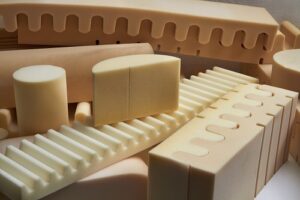Differences Between Polyurethane and Rubber
Both rubber and polyurethane are regarded for their elastic, flexible properties. Each material is commonly used in the manufacturing of parts and components in the automotive industry. The largest user of polyurethane reaction injection-molded (RIM) parts is the automotive industry. Because it is typically more durable than rubber, polyurethane is used in applications that require continual exposure to stress or constant stretching and offer a degree of flex, with plenty of strength. Such body parts as fenders, bumpers, and spoilers are made of polyurethane.
Rubber’s place in the automotive industry comes down to a single mechanical property—absorption. Rubber is more effective in absorbing vibrations than polyurethane. That’s why the material is used for making tires, but also for seals, gaskets, and bushings. In regards to the latter, when it comes to polyurethane vs. rubber bushings, rubber is more effective in dampening and absorbing road-noise, vibrations, and hardness than bushings made from polyurethane. Rubber components make for a quieter, smoother ride, and are generally the original equipment from the manufacturer. In applications that necessitate anti-vibration bushings, rubber is the choice material.
On the other hand, polyurethane gives the driver a more enhanced feel for the road, offering the driver the sensation that he or she is an extension of the vehicle itself. Rubber will wear out sooner, too, due to the constant stretching and stress on the part.
Still, rubber costs less than polyurethane, which may be another reason that manufacturers use rubber components when it comes to a vehicle’s suspension. The production of polyurethane is a more complex process. As a result, raw polyurethane costs more than natural or synthetic rubber.
Read more: WHAT’S THE DIFFERENCE BETWEEN POLYURETHANE AND RUBBER?

